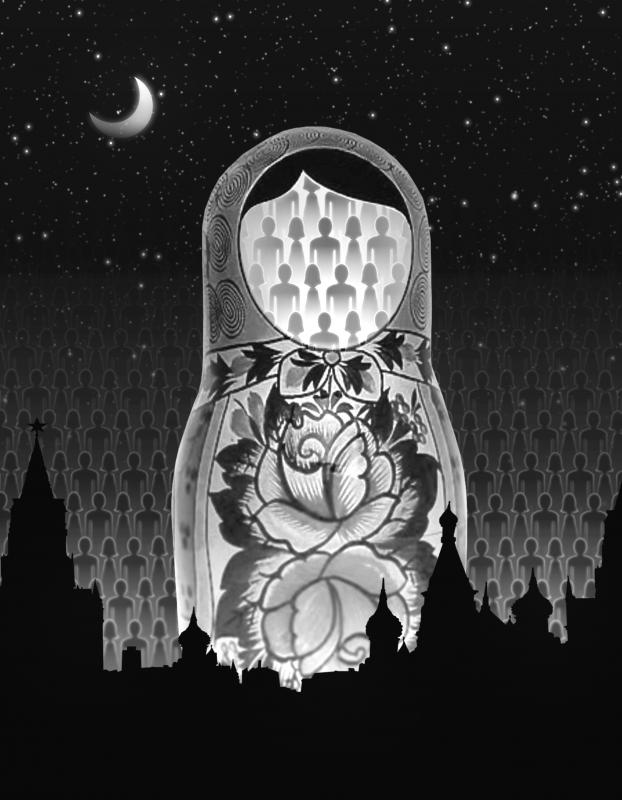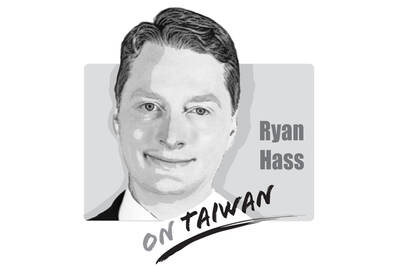Russian President Vladimir Putin’s attack on Ukraine showed the world that a resurgent Russia means, out of necessity, an imperialist Russia. It also revived discussions about whether Russia needs to be “decolonized,” or perhaps “defederalized,” to bury its imperialist ambitions and subdue its military threat.
A breakup of today’s Russia, similar to the dissolution of the Soviet Union, is seen as a possible, for some even the most desirable, outcome of a failed Ukraine invasion. Regrets have been voiced that the US did not make it a goal in the 1990s, when post-Soviet Russia lay in ruins and struggled to hold onto one, tiny secessionist region: Chechnya.
These discussions bring on a sense of literary deja-vu — a Russia turned into a quilt of statelets has been almost too easy to imagine since the Soviet Union came apart with such seeming ease.

Illustration: Yusha
In the 2013 novel Telluria, Vladimir Sorokin, one of the most uncannily precise prophets of Russia’s turn to fascism, had one of the characters write of the Russian empire:
“If she, this splendidly ruthless giantess in her diamond diadem and her snow mantle, collapsed conveniently in February 1917, and disintegrated into several states of manageable size, everything would have turned out in the spirit of modern history, and the peoples held down by czarist power finally would have come into possession of their post-imperial identities and lived in freedom.”
However, that is not how it went.
In Telluria, Russia is finally split into mostly autocratic principalities of “manageable size” after a series of domestic shake-ups. Not even Sorokin saw a lost invasion as a trigger for a breakup of Russia.
Yet a defeat in Ukraine, accompanied by Western economic pressure, could realistically lead to an economic disaster such as the one that set off the Soviet Union’s collapse, and could thus reinforce the centrifugal tendencies that Putin is so proud of having stifled by establishing his “vertical of power.”
There are good reasons it might make sense even for the Russian public — especially those who do not live in Central Russia.
In a way, Putin has not just unleashed the breakup discussion with his irrational attack. He has also enabled it intellectually by talking of “historical Russia,” which in his view includes much of modern Ukraine.
If it is possible to discuss a core Russian state, rather than the country in its current borders, then it can be argued that this core is much smaller than today’s Russia — if one peels off all the country’s imperial conquests, some of which, including the takeover of much of Siberia, predate 1721, when Russia officially became an empire.
In a way, the inclusion of some territories in the Russian Soviet Socialist Republic — the entity that became the Russian Federation when the Soviet Union gave up the ghost — is as much a Soviet-era accident as the higher-grade statehood of former Soviet republics such as Ukraine, Uzbekistan or Moldova.
Tatarstan, the populous Russian region on the Volga, is a case in point. Last year, 55 percent of schoolchildren in its capital, Kazan, chose Tatar as their native language. Is this place, conquered by Ivan the Terrible in 1552, really part of core Russia in any more of a meaningful way than, say, Kazakhstan was? Many locals would argue otherwise.
Is Tuva, which joined the Soviet Union only in 1944 and lived through separatist riots in the early 1990s, part of Russia’s historical core? Is Dagestan, conquered in the early 19th century, where fewer than 4 percent of schoolchildren take Russian as native language classes?
Would not all of these places have been independent states today had the communist founders of the Soviet Union constituted them as “union republics” rather than “autonomous republics” within Russia?
All these questions are fodder for the policymakers of Russia’s geopolitical rival nations. Fomenting nationalist (or anti-colonial, as it can be framed) sentiment in a Russia weakened by a less-than-successful war would make sense on several levels — more sense than in the 1990s.
An aggressive, irrational leader finding his way to the top in Moscow is no longer a theoretical danger; it is easy to see how it can happen again. The best way to guard against that possibility is to defeat Putin militarily and ideologically. By using the same kind of historical talking points that Putin uses to justify Russia’s imperial ambitions, it would be possible to turn his main ideological weapon against him.
At the same time, the Ukraine campaign so far shows that the Russian military struggles to supply its troops and fight effectively across Ukraine’s vast expanse. What would Putin do with multiple secessionist rebellions in a country as enormous as Russia?
It could be said that splintering Russia would not really remove its revanchist ability to pick itself up after bad defeats and major territorial losses and become a threat to its rivals again. It did so after the Bolshevik Revolution and the punishing Treaty of Brest-Litovsk with the Central Powers, and it did so again after the Soviet project wound down.
A Russia dismembered would not necessarily stay that way; extreme nationalist and populist forces might even be empowered by such a humiliation, and they would inherit Russia’s nuclear arsenal, which would not simply disappear even if Russia disintegrates.
However, those who entertain the “decolonization” of Russia are not necessarily thinking centuries ahead. A couple of decades might be enough to integrate Russia’s neighbors into the Western world and build stronger defenses against further imperialist resurgence.
As a Russian, I get an uneasy feeling from all this talk of my country’s dismemberment, as if Russia were a cancer patient lying semiconscious on an operating table with only multiple amputations able to stop the tumor from metastasizing further. I hate the idea that the only way to stop it being a threat to neighboring countries is to break us up, and I hope it is not the imperialist in me that rebels at the thought.
Russia’s vastness and diversity are foundational to our nationhood as it exists today. “Manageable size” is not us.
Yet, on an intellectual level, I understand that many Russians might actually be well served by the Russian Federation’s dissolution. As Putin strengthened his “vertical” after then-Russian president Boris Yeltsin offered Russia’s regions “as much sovereignty as you can swallow,” the recentralization bled Russia’s periphery.
Only 23 of Russia’s 85 regions are not funded by federal subsidies this year, most of them with a predominantly ethnic Russian population (Tatarstan is the exception). This creates the impression that a majority of the provinces, and in particular those with distinct national identities, would be helpless if separated from the center.
However, that is just how the Putin system operates, sucking money out of the periphery and then “generously” redistributing some of it back.
Viktor Suslov, an economist at the Russian Academy of Sciences, has built up a body of work showing how this happens.
In a 2018 paper, he and his collaborators said that Russia’s Central Federal Region, which includes Moscow, acts like a black hole that absorbs about 35 percent more resources from other regions than it gives back. Siberia, the Ural region, the Far East and the Northwest (which includes St Petersburg) each contribute 10 to 13 percent more than they receive.
Unsurprisingly, Suslov is based in Novosibirsk, the center of one of the regions whose lifeblood is drained by the great Moscow pump.
It is not clear whether a fairer redistribution of resources — and an end to the mass migration of people following the money to Moscow — can be achieved without radical decentralization, perhaps even a full breakup. Some of Russia’s constituent parts could even end up with more reasonable political systems than the quasi-monarchy to which Moscow keeps reverting — although many would not, as was demonstrated in the 1990s when regional kingpins became far more authoritarian than the erratic man in the Kremlin.
In the Urals, Siberia and the Far East, the unruly spirit of pioneers and former convicts is still alive. Omsk artist Damir Muratov’s United States of Siberia flag — white snowflakes on a field of blue, green and white stripes — is more than a Jasper Johns send-up: One can actually imagine the country that would fly it.
I still hope against hope that democracy, an end to aggressive imperialism, a commitment to the equal development of territories and a true equality of all ethnic groups are possible within Russia’s current borders.
However, this hope might well be no more than an atavism. Russia does not carry its size well. Perhaps it will never learn.
Leonid Bershidsky, formerly Bloomberg Opinion’s Europe columnist, is a member of the Bloomberg News Automation Team.
This column does not necessarily reflect the opinion of
the editorial board or Bloomberg LP and its owners.
When US budget carrier Southwest Airlines last week announced a new partnership with China Airlines, Southwest’s social media were filled with comments from travelers excited by the new opportunity to visit China. Of course, China Airlines is not based in China, but in Taiwan, and the new partnership connects Taiwan Taoyuan International Airport with 30 cities across the US. At a time when China is increasing efforts on all fronts to falsely label Taiwan as “China” in all arenas, Taiwan does itself no favors by having its flagship carrier named China Airlines. The Ministry of Foreign Affairs is eager to jump at
The muting of the line “I’m from Taiwan” (我台灣來欸), sung in Hoklo (commonly known as Taiwanese), during a performance at the closing ceremony of the World Masters Games in New Taipei City on May 31 has sparked a public outcry. The lyric from the well-known song All Eyes on Me (世界都看見) — originally written and performed by Taiwanese hip-hop group Nine One One (玖壹壹) — was muted twice, while the subtitles on the screen showed an alternate line, “we come here together” (阮作伙來欸), which was not sung. The song, performed at the ceremony by a cheerleading group, was the theme

Secretary of State Marco Rubio raised eyebrows recently when he declared the era of American unipolarity over. He described America’s unrivaled dominance of the international system as an anomaly that was created by the collapse of the Soviet Union at the end of the Cold War. Now, he observed, the United States was returning to a more multipolar world where there are great powers in different parts of the planet. He pointed to China and Russia, as well as “rogue states like Iran and North Korea” as examples of countries the United States must contend with. This all begs the question:
In China, competition is fierce, and in many cases suppliers do not get paid on time. Rather than improving, the situation appears to be deteriorating. BYD Co, the world’s largest electric vehicle manufacturer by production volume, has gained notoriety for its harsh treatment of suppliers, raising concerns about the long-term sustainability. The case also highlights the decline of China’s business environment, and the growing risk of a cascading wave of corporate failures. BYD generally does not follow China’s Negotiable Instruments Law when settling payments with suppliers. Instead the company has created its own proprietary supply chain finance system called the “D-chain,” through which